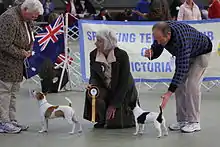Tenterfield Terrier
The Tenterfield Terrier is a dog breed developed in Australia. They are a strong, active, hardy and agile dog, their smooth short coat making them 'easy care' family companions.
| Tenterfield Terrier | |||||||||
|---|---|---|---|---|---|---|---|---|---|
 Two champion Tenterfield Terriers: a tan and white; and a tri-colour. | |||||||||
| Origin | Australia | ||||||||
| |||||||||
| Dog (domestic dog) | |||||||||
Appearance

Tenterfield terriers must be predominantly white as required by he the Breed Standard of the ANKC. They are not exaggerated in any features. They have a square or compact body, a wedge shaped head with equal length from occiput to stop and stop to the end of the nose. This gives the head parallel head planes, making the head unusual in this Group. The Tenterfield Terrier may also have semi-erect ears or pricked ears, the latter being more common. Tenterfield Terriers stand around 28 cm (11 inches) high and can come in tan and white, black and white, liver/tan/white tri-coloured or black/tan/white tri-coloured.[1] Their unique feature is their naturally occurring bob tail which can come in any length.[2]
History
The forebears of the Tenterfield Terrier accompanied Australia's first European settlers who sailed from Portsmouth in the south of England. These dogs were vermin killers. The smallest of them were selected to play that role on ships, which is how they arrived in Australia.[3] Large dogs would not have fared as well in the cramped shipboard environment where vermin found nooks and crannies. Small terriers had an advantage in that environment. Miniature individuals of the Fox Terrier breed suited the role, as their original breeding matched the new task closely.
By the late 19th century a dog type known as the Miniature Fox Terrier (known colloquially as "Mini Foxies") was well established in rural Australia as a vermin killer and family companion. By the 1920s the dog had become a fixture in urban households.[4]
The name "Tenterfield" does not denote the terrier's exact place of origin. Rather, it may have derived from a well known breeder. The dog was bred extensively in and around northern New South Wales.[5] Tenterfield is one of many localities in Australia in which small terriers of this type were kept. The town of Tenterfield is significant in Australian history for the Tenterfield Oration on independence from Britain. Additionally, the owner of the town's saddlery a man named George Woolnough, was immortalized by his grandson entertainer Peter Allen as the "Tenterfield Saddler". Tenterfield residents attest that Mr. Woolnough owned and loved a number of these terriers,[6] though unfortunately no photographs of his dogs are known.
Accordingly, the name Tenterfield Terrier was suggested in the 1990s by television gardening personality Don Burke,.[7]
Breed development
In 1991 a group of enthusiasts from the state of South Australia formed the Miniature Fox Terrier Club of South Australia, separate from the Miniature Fox Terrier Club of Australia, which had been operating for some time. In 1992 they met with owners from other states to discuss the future of the Clubs. At that time, it became evident that there were differences as to the preferred type of dog that would represent the Miniature Fox Terrier breed. Further, challenges to the name “Miniature Fox Terrier” were being mounted, and threatened to preclude recognition by the ANKC which was a priority among some breeders. The establishment of the Tenterfield Terrier Club of Australia Inc took place in January 1993, by approximately 85% of votes returned to the ANKC by fanciers across NSW WA and SA.[5] In 2002, the Tenterfield Terrier was recognized by the ANKC and placed in Group 2, Terriers.
The Tenterfield Terrier breed standard[1] differs from that of the Miniature Fox Terrier, and although they are sometimes confused, the two breeds have been developing along divergent lines for some time and are now separate breeds.
Health and temperament
Despite its small stature, the dog is friendly with an outgoing, adaptable nature, bold in the way of terriers and is intelligent. The coat is low maintenance for grooming purposes. Although they can live to 20 years in good health, the average lifespan is from 12 to 14 years.[7]
References
- "ANKC Tenterfield Terrier Breed Standard". ANKC Ltd. Archived from the original on 6 July 2011. Retrieved 24 Jan 2012.
- "Tenterfield Terrier". Jane Harvey. Retrieved 24 Jan 2012.
- "Information On The Tenterfield Terrier". Tenterfieldsa.com. Retrieved 11 December 2017.
- "Tenterfield Terrier Breed Information". The Dog Site. Retrieved 24 Jan 2012.
- "History". Tenterfieldterrier.info. Retrieved 11 December 2017.
- National Tenterfield Terrier Council (Australia)
- "Tenterfield Terrier". Burkesbackyard.com.au. 19 September 2013. Retrieved 11 December 2017.